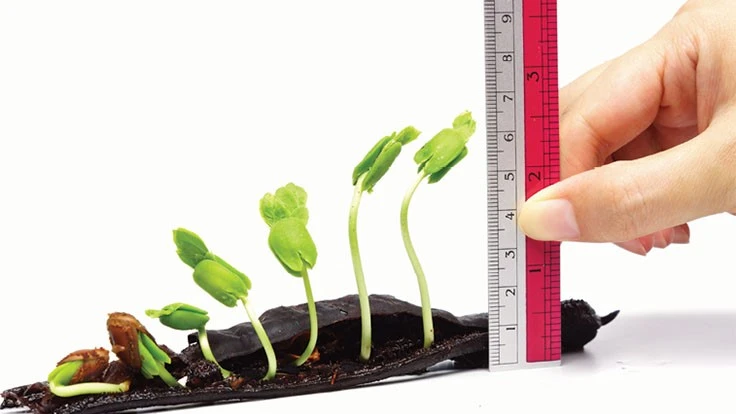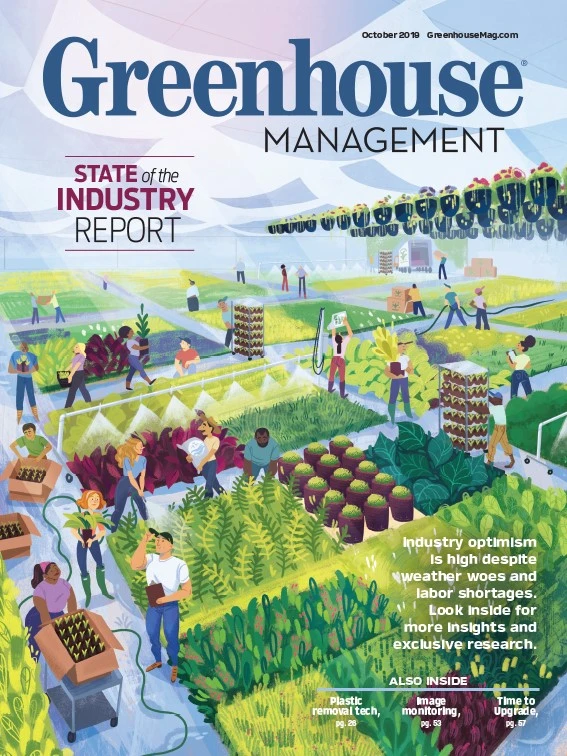
_fmt.png)
Monitoring growth and development is an important practice to ensure that greenhouse crops remain on schedule and to rectify issues early in production. Clear examples of this type of monitoring are common with holiday crops with long production times such as poinsettia and Easter lily. For poinsettias and Easter lilies, a tool known as graphical tracking is used to monitor and manipulate height, while leaf counting is standard practice for Easter lilies to ensure proper timing. While methods such as these are available for a variety of potted flowering crops in the greenhouse industry, tracking the growth of young plants such as annual bedding plant seedlings is not quite as straightforward.
When it comes to the production of plugs, it is all about producing a quality crop on time while optimizing inputs (fertilizer, water, energy and fuel). Thus, it is important to monitor seedling growth during production to ensure that plugs are of good quality and their growth rate matches targeted finishing time. By monitoring seedling growth in different zones, growers can optimize inputs like fertilizer, water, energy for lighting and fuel for heating. Monitoring seedling growth manually or using destructive methods is impractical in greenhouses. One available option is to use imaging technology to noninvasively monitor seedling growth in large areas.

While imaging of crops is by no means a new technology, it has been seldom used to monitor seedling growth. Recent advances in imaging technology and software have resulted in techniques that provide increasingly rapid and accurate measurements of seedling growth. An estimate of leaf area is one of the primary measurements obtained from imaging. Leaf area can also provide a good indication of biomass accumulation, as these two qualities are physiologically connected within the plant. This makes sense when we consider the leaf as the primary site for photosynthesis. As the leaf area increases, the amount of surface area for light interception is increasing. Thus, we can conclude that as leaf area increases, more light is absorbed by the leaf and is available for photosynthesis, ultimately leading to increases in biomass accumulation. In this article, we conducted a ‘pilot study’ to test the viability of these imaging techniques in monitoring the growth of plug trays using a high-quality image station. Our future idea is to transfer this technology, if it proves viable, to simpler measurement systems like cameras mounted on irrigation booms or placed at stationary locations in a greenhouse.


Monitoring growth using imaging
To test the viability of these imaging techniques in monitoring the growth of plug trays, we conducted research using an Aris Top View Image Station (Fig. 1) located at Purdue University in West Lafayette, Indiana. The two primary objectives of this study were to 1) evaluate whether imaging could provide an accurate leaf area estimation for entire plug trays; and 2) determine if these leaf area estimations could be used to predict the dry weight of plug trays. To evaluate a wide variety of crops, seeds of pansy (Viola ×wittrockiana ‘Matrix Yellow’), petunia (Petunia ×hybrida ‘Dreams Midnight’), tomato (Lycopersicum esculentum ‘Early Girl’) and zinnia (Zinnia elegans ‘Zahara Fire’) were sown in 128-cell plug trays and grown in a common greenhouse environment. Three days after germination, one tray of plugs was selected from each species for imaging and harvest measurements. From this point, data collection occurred every two days until the leaf canopy completely closed and the plugs were considered “pullable” and ready for shipment. Software inside the image station accurately separated plants from the background (Fig. 2), which is crucial for accurately estimating leaf area. The image station was used to estimate leaf area (imaged leaf area), while the harvest measurements included leaf, stem and root dry weights as well as leaf area using a leaf area meter (measured leaf area) to test the accuracy of our imaging.
We found that a strong relationship existed between the imaged leaf area and the measured leaf area (Fig. 3), which displays that the imaged leaf area provides an accurate estimation for the actual leaf area of the plug tray. However, as leaves began to overlap later in production, it became apparent that the imaged leaf area was underestimating the measured leaf area of the plug tray. While this is an unfortunate limitation of using the imaging software, this imaged leaf area can still be used to predict what the measured leaf area would be. Additionally, we found a strong relationship between imaged leaf area and the total dry mass of the plug tray (Fig. 4). Thus, we confirmed that the imaged leaf area could be used as a means to monitor the growth of plug trays. By tracking growth in this way, we suggest that accurate predictions on plug quality can be made nondestructively.

Concluding recommendations and remarks
Our pilot study indicates that imaging technology can be potentially used to monitor growth rate of bedding plant seedlings. The imaging technology described here provides one of the most efficient, non-destructive and accurate means to do so. From these measurements, one can quickly monitor the growth of the crop and make environmental or cultural adjustments as issues or delays arise. Additionally, it is important to note that the use of this imaging software to estimate leaf area is only the beginning of what measurements are possible. By looking further into what light is reflected or re-emitted by the leaves, we can begin to anticipate and diagnose a variety of environmental- and nutritional-based stress responses. As this technology continues to be developed, we hope to present novel ways of monitoring growth and development to further facilitate optimal production in controlled environments.

Explore the October 2019 Issue
Check out more from this issue and find your next story to read.
Latest from Greenhouse Management
- Anthura acquires Bromelia assets from Corn. Bak in Netherlands
- Top 10 stories for National Poinsettia Day
- Langendoen Mechanical hosts open house to showcase new greenhouse build
- Conor Foy joins EHR's national sales team
- Pantone announces its 2026 Color of the Year
- Syngenta granted federal registration for Trefinti nematicide/fungicide in ornamental market
- A legacy of influence
- HILA 2025 video highlights: John Gaydos of Proven Winners





